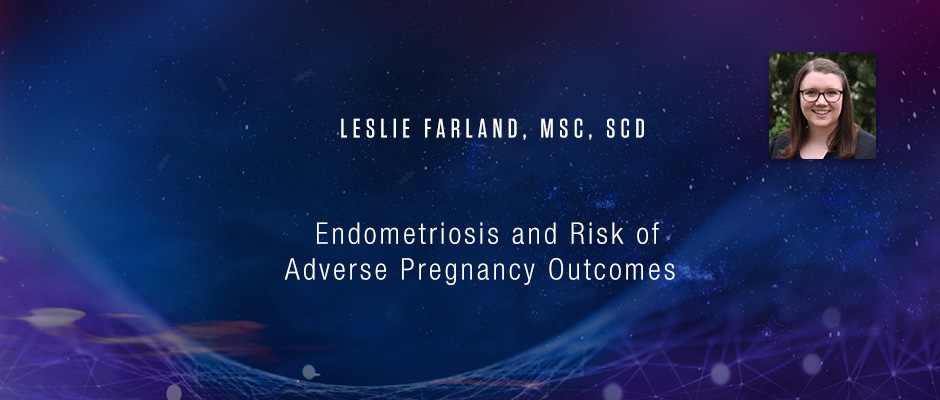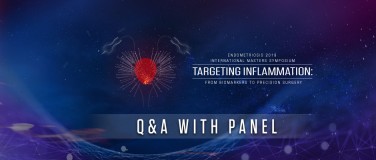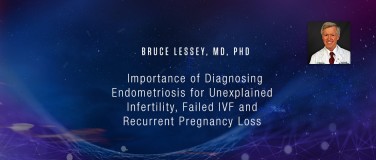Bruce Lessey, MD, PhD - Importance of Diagnosing Endometriosis for Unexplained Infertility, Failed IVF and Recurrent Pregnancy Loss
Endometriosis Foundation of America
Medical Conference 2019
Targeting Inflammation:
From Biomarkers to Precision Surgery
March 8-9, 2019 - Lenox Hill Hospital, NYC
https://www.endofound.org/medicalconference/2019
Thank you. I'd like to start by thanking the EFA for inviting me to speak today and for funding some of my research as well. So I'm delighted to be talking about a topic that I think segues nicely from the topics that we've been hearing this afternoon. Today I'll be talking about endometriosis and risk of adverse pregnancy outcomes and really thinking about how we study endometriosis on a population level. The work that I'll be presenting here today has been in collaboration with several colleagues in the audience, especially Dr. Stacey Missmer.
As we heard, the relationship between endometriosis and infertility is complicated. For many women with endometriosis, they're presenting first with pain symptoms. Some of these women also experience infertility, and so they have severe pain as well as severe infertility. We also heard about this idea that there are individuals who present for infertility or an IVF workup and then are inadvertently diagnosed with endometriosis. Research from our group found that women with endometriosis actually had a twofold increased risk of having a diagnosis of infertility later in life. However, the vast majority of these women ultimately achieved a live birth, over 85% in the population that I'm going to be talking about today.
There are many mechanisms through which endometriosis could influence adverse pregnancy outcomes. The population has been consistent for some of these. But I wanted to walk through some of these mechanisms. We've heard about them but I wanted to kind of reinforce these concepts. We've talked about this idea that women with endometriosis may have an altered uterine environment, specifically related to progesterone resistance. This could increase the risk of pregnancy loss. We talked about this idea of ectopic pregnancies earlier as well as issues of growth restriction.
Inflammation is obviously the topic of today and tomorrow. We know from studies of women that women with endometriosis have been found to have higher levels of inflammation both locally in the peritoneal cavity as well as systemically. Through this mechanism of inflammation, we could see an increased risk of gestational diabetes as well as hypertensive disorders of pregnancy including preeclampsia and gestational hypertension as well as preterm birth. It's also been hypothesized that women with endometriosis may have inadequate uterine contractility. This obviously could influence a variety of things including pregnancy loss, preterm birth, and growth restriction.
Lastly, women with endometriosis may have defective placentation, which also could influence many of these endpoints, but specifically preterm birth and growth restriction. So as I mentioned, many studies have investigated the relationship between endometriosis and adverse pregnancy outcomes. But I wanted to highlight some of the major limitations of this work. Many of these studies have been relatively small and they've been conducted within one fertility clinic. So this leads to issues of limited power. This also leads to issues, especially in the United States, of access to fertility care as well as access to treatment. So these women may be different than our general population of endometriosis.
Additionally, as I talked about, many of the women with endometriosis may not experience infertility, and so it's not representing the spectrum of endometriosis disease that's predominantly pain presenting. Many studies that have investigated this question have lacked specific control for important confounding factors. By confounding, I mean factors that are associated both with endometriosis and with our adverse pregnancy outcome of interest. Specifically, the ones that we care most about are parity, age, and history of infertility.
Lastly, there's been some medical record linkage studies that have investigated these questions. I just want to keep in mind that some of these studies may underestimate some of the endpoints that we're interested in. So specifically, if we're looking at hospitalization for endometriosis, this may represent more severe disease, as well as miscarriage as reported in a medical record, may represent more severe endpoints. So the objective today is to show data based on the Nurses' Health Study II to look at the relationship between endometriosis and adverse maternal and pregnancy outcomes. I really would like for us to think about this as an example of how we can study endometriosis on a population level.
I also wanted to highlight that this work is under review right now, so it's not currently published. In order to investigate this question, I used data from the Nurses' Health Study II, which is this large perspective cohort study of over 116,000 female nurses. These nurses were between the ages of 25 to 42 in 1989 when the cohort began. These individuals have been followed every two years to collect detailed information on a variety of important covariates, including endometriosis, adverse pregnancy outcomes. Over the course of this population under study, we have very good follow up, over a 90% cumulative follow-up rate.
So in this cohort, endometriosis was based on self-report. Women were asked whether or not they had laparoscopically confirmed endometriosis or whether they had physician-diagnosed endometriosis. Validation work from our cohort saw that when compared to medical records, we saw the highest concordance, not surprisingly, with laparoscopically confirmed endometriosis and a lower concordance when it was just physician-diagnosed endometriosis when we compared this to the medical record. So for the purpose of this analysis, we just used laparoscopically confirmed endometriosis as our case definition and we excluded the physician-diagnosed endometriosis. But this was, obviously, a strong assumption, and so we tested this assumption in sensitivity analyses later.
Pregnancy information was first asked in 1989 when our cohort began. Women were asked a variety of questions about whether or not they had pregnancies lasting longer than six months, history of spontaneous abortion or induced abortion. And then that information was updated on every questionnaire every two years subsequently. In 2009, all participants were sent a very detailed questionnaire about each individual pregnancy. That's where we collected the majority of the information I'll be presenting today. So we looked at a variety of adverse pregnancy outcomes. Given some of the literature that was talked about earlier, we were interested specifically in association with pregnancy loss. We looked at spontaneous abortion, ectopic pregnancy, as well as stillbirth.
Validation work with these self-reported questionnaires has found relatively high validity of these outcomes. Our population under study was all pregnancies. We also looked at maternal outcomes, which I'm defining as gestational diabetes, gestational hypertension, and preeclampsia. For the analysis that I'll be presenting today, we combined gestational hypertension as well as preeclampsia. The population that we looked at was among all births in this population. Lastly, we looked at the pregnancy outcomes of preterm labor, defined as less than 37 weeks gestation, and singleton low birth weight, less than 5.5 pounds.
What I wanted to highlight here is that given that this is a large cohort of medical professionals, we see relatively high validation with medical records for all of these adverse pregnancy outcomes that we studied. I'm going to talk very quickly about the world that I live in a lot of times, which is the statistics. But essentially, we did a log-binomial regression, which estimated the relative risks. We took into account multiple pregnancies per women and we adjusted a priori for a variety of those factors that I talked about as being potential confounding factors. So of note, we were able to adjust for age at menarche, menstrual cycle length, parity, history of infertility, and year of pregnancy.
I also wanted to highlight some of the tests for heterogeneity we investigated. In the MFM literature, it shows that there is a difference in some of these adverse pregnancy outcomes by maternal age as well as parity history and infertility history. So we stratified by these differences and tested for effect modification. Lastly, we did a variety of sensitivity analyses to test some of our assumptions. I don't have time today to talk through these but I'm happy to talk about them offline. From the over 116,000 women, over 100,000 of these women reported having at least one pregnancy which resulted in 188,000 unique pregnancies, 8,875 of which had a history of laparoscopically confirmed endometriosis.
So here I'm showing you characteristics of our population at baseline among women who reported a pregnancy stratified by whether or not they had a history of laparoscopically confirmed endometriosis. Many of the patterns we would expect to see, kind of given the known epidemiology of endometriosis, we do see. Women with endometriosis on this kind of far column were more likely to be primiparous and have lower parity. They were also more likely to be ever oral contraceptive users, to report a lower age at menarche, and to report irregular menstruation, also to report a lower BMI at age 18 and currently.
So here I'm showing you relative risks or these effect estimates and 95% confidence intervals. Just as a reminder, the reference value of relative risks is one. So relative risks above one suggest an increased risk. So here we saw that women with endometriosis had a greater risk for all of our pregnancy loss variables. They had around a 40% increased risk of spontaneous abortion, a 46% risk of ectopic pregnancy as well as stillbirth. When we looked at heterogeneity by age--so here the younger ages are in this dark blue color and the older ages are in this light blue color--we saw important effect modification, especially for spontaneous abortion or miscarriage.
So the relationship between endometriosis and spontaneous abortion was stronger among women less than 35 years old. When we looked at heterogeneity by parity we also saw statistically significant effect modification among miscarriage. So here two or greater pregnancies are in this dark gray color and primiparous pregnancies are in this light gray color. We saw that the relationship between endometriosis and miscarriage was stronger among primiparous women. Lastly, we looked by the history of infertility, which I think is critical, kind of given the conversations that we're having for the role that infertility plays in endometriosis.
Here we saw the relationship with ectopic pregnancy changed. The relationship between endometriosis and ectopic pregnancy was stronger among individuals who did not have a history of infertility. Moving on to our overall effect estimates for maternal outcomes, we saw that endometriosis was associated with a 35% increased the risk of gestational diabetes and a 30% increased risk of preeclampsia or gestational hypertension. We saw that the relationship with gestational diabetes was stronger among younger women. When we looked at parity, we saw that the relationship for both gestational diabetes and for preeclampsia was stronger among second or greater pregnancies. When we looked at the history of infertility, we saw that the relationship with gestational diabetes was stronger, again, among this group of women with endometriosis who did not have a history of infertility.
So moving to my last set of endpoints, we saw that women with a history of endometriosis had a modest increased risk of preterm birth as well as low birth weight. We saw no differences when we looked at the age of the pregnancy. We did see differences by the history of pregnancy. So again, the relationship between endometriosis and preterm birth was stronger among second or greater pregnancies. Lastly, when we looked at the relationship stratified by infertility, we saw that the relationship with preterm birth again was stronger among individuals who did not report a history of infertility in this dark green color.
I realize that was a lot of of data. I briefly wanted to talk through some of the strengths and limitations of studying endometriosis on a population level. Because this was based on self-report we had limited information on endometriosis staging. Although, as we heard today, the staging does not consistently correlate with either infertility or pain severity. We also did not have information on lesion excision or the intensity of the surgery that was performed. The data for all of our endpoints is based on self-report, but hopefully, I have shown you today that there is relatively high validity with the medical records for many of these endpoints.
We all know this, but it's something that we haven't really talked about, is there's this really severe delay between endometriosis disease symptoms and diagnosis. So when we're studying endometriosis, it's sometimes difficult on a population level to determine exactly when that disease starts. So the exact onset for endometriosis is not really knowable. We did do sensitivity analyses to test some of the assumptions that we made. This is the largest population-based study looking at endometriosis in relation to adverse pregnancy outcomes. Hopefully, I argued successfully today that we were able to capture the entire spectrum of endometriosis through cases that were both pain-presenting as well as potentially infertility-presenting.
We stratified by important variables. I think this heterogeneity in the relationships I showed can really explain some of the difference that we're seeing across studies of endometriosis. It's not one disease, and I think we saw that today. Additionally, we were able to statistically account for multiple pregnancies so our effect estimates are more precise. So to briefly summarize what I talked through today, we saw that endometriosis was associated with many adverse maternal and pregnancy outcomes. But I think we saw some really important variation. We saw variation by age at pregnancy, the relationship for spontaneous abortion and gestational diabetes was stronger among younger women.
We also saw heterogeneity by parity. We saw that the relationship with spontaneous abortion was strongest for first pregnancies, while the relationship with gestational diabetes, gestational hypertension, and preterm birth was stronger among second or greater pregnancies. Lastly, I think this relationship or effect modification by history of infertility is really interesting, given that we saw consistent effect modification among women who did not report a history of infertility. And that changed the effect estimates for ectopic pregnancy, gestational diabetes, as well as preterm birth.
Of future research, I think, really must incorporate this entire spectrum of endometriosis, and specifically, this variation among endometriosis phenotypes. Additionally, consider extremes in pregnancy phenotypes, which we weren't adequately powered to do, and think about potential biological pathways with the goal to inform screening as well as prevention interventions for women with endometriosis. I wanted to think my collaborators and our funding sources and the EFA for having us here today. So thank you.










